Berzerk
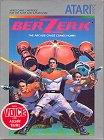 The Game: You’re alone in a maze filled with armed, hostile robots who only have one mission – to kill you. If you even so much as touch the walls, you’ll wind up dead. You’re a little bit faster than the robots, and you have human instinct on your side…but even that won’t help you when Evil Otto, a deceptively friendly and completely indestructible smiley face, appears to destroy you if you linger too long in any one part of the maze. The object of the game? Try to stay alive however long you can. (Atari, 1983)
The Game: You’re alone in a maze filled with armed, hostile robots who only have one mission – to kill you. If you even so much as touch the walls, you’ll wind up dead. You’re a little bit faster than the robots, and you have human instinct on your side…but even that won’t help you when Evil Otto, a deceptively friendly and completely indestructible smiley face, appears to destroy you if you linger too long in any one part of the maze. The object of the game? Try to stay alive however long you can. (Atari, 1983)
Memories: Already released in a near-picture-perfect version on the Atari 2600, Berzerk was surely an easy game to port to that console’s newer, more powerful sibling. But the 2600 version was so good, what could Atari do to top it?
B.C.’s Quest For Tires
 The Game: As beleaguered caveman B.C., you’ve just discovered the wheel. That’s the good news. The bad news is that, on the same day that you harness mechanical motion for the first time, you’re also going to discover the traffic accident. Jump over holes in the ground, rocks and rolling boulders, and duck under tree limbs – and then you’ve got to survive showing your new evolutionary step off to the Mrs.! (Sierra On-Line, 1983)
The Game: As beleaguered caveman B.C., you’ve just discovered the wheel. That’s the good news. The bad news is that, on the same day that you harness mechanical motion for the first time, you’re also going to discover the traffic accident. Jump over holes in the ground, rocks and rolling boulders, and duck under tree limbs – and then you’ve got to survive showing your new evolutionary step off to the Mrs.! (Sierra On-Line, 1983)
Memories: B.C.’s Quest For Tires is one of those games that immediately brings the word “Colecovision” to mind – it was a striking game for its day, and this was the platform where it truly excelled (though it was also available on several home computers as well). Johnny Hart’s comic strip wasn’t quite in the Garfield stratosphere of daily newspaper comics, but it was popular enough that its characters would seem familiar.
The Activision Decathlon
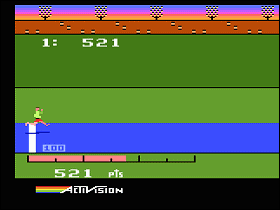
 The Game: Let the games begin! The Activision Decathlon puts players in the middle of ten summer Olympic events, each of which requires fast and furious joystick action, and careful timing on the fire button, to measure the player’s physical prowess. Events include 100 and 400 meter dashes, long jump, discus, shot put, high jump and more. (Activision, 1983)
The Game: Let the games begin! The Activision Decathlon puts players in the middle of ten summer Olympic events, each of which requires fast and furious joystick action, and careful timing on the fire button, to measure the player’s physical prowess. Events include 100 and 400 meter dashes, long jump, discus, shot put, high jump and more. (Activision, 1983)
Memories: Olympic-themed video games began to pile on pretty thick starting with Track & Field in the arcade, and Activision was ahead of the curve as well, getting The Activision Decathlon on the market a year before the 1984 games. Like Track & Field, Decathlon made use of a unique control scheme that brought some real physicality to the game, requiring players to work up at least a little bit of a sweat. It also cost many an otherwise well-constructed controller its life.
Track & Field
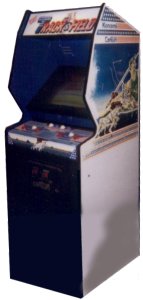
 The Game: It’s time for the 1984 Olympics! Qualify and compete in such events as the 100-meter dash, the long jump, javelin throw, and the shot-put. (Konami, 1983)
The Game: It’s time for the 1984 Olympics! Qualify and compete in such events as the 100-meter dash, the long jump, javelin throw, and the shot-put. (Konami, 1983)
Memories: Though the above summary of Track & Field may seem unjustly short, that really summed up the game, which was actually quite fun, especially if you could get a second player to compete against you at the same time. Very rarely have I given a sports game the time of day unless it was a good one (such as Atari’s Pole Position) or a game so goofy that it transcended its genre (i.e. the hilarious Odyssey2 Computer Golf! cartridge). Track & Field was a true rarity – a decent sports game.
Tropical Angel
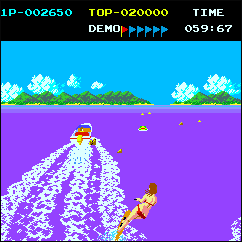 The Game: You’re a water-skiing bikini babe who’s trying to stay above water; the problem is that the water’s full of rocks that can cause you to take a painful tumble if you hit them, and the even bigger problem is that the guy driving the boat that’s pulling you along seems to have it in for you! The boat seems to be deliberately trying to pull you into harm’s way, and only fast joystick work and a sharp eye will keep you from winding up on the rocks. (IREM, 1983)
The Game: You’re a water-skiing bikini babe who’s trying to stay above water; the problem is that the water’s full of rocks that can cause you to take a painful tumble if you hit them, and the even bigger problem is that the guy driving the boat that’s pulling you along seems to have it in for you! The boat seems to be deliberately trying to pull you into harm’s way, and only fast joystick work and a sharp eye will keep you from winding up on the rocks. (IREM, 1983)
Memories: Man, whoever’s pulling that boat is just a misanthropic jerk. If you imagine that there’s a Tron-like world beyond the screen, I can only hope that the bathing-suited honey in this game finds herself a better boat driver after the game’s over.
Professor Pac-Man
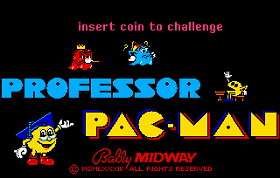 The Game: The denizens of Pac-Land must surely know how to do something other than just devour dots and munch monsters. And they learn from Professor Pac-Man himself, the dean of dot-gobblers. Professor Pac-Man poses questions of all kinds to you (and an opponent, if you have a second player), including visual recognition tests and matching puzzles. A Pac-Man gobbles a row of dots from left to right, counting down the seconds you have to correctly answer the question. Correct answers gain points and fruit, while incorrect answers will cost you. Lose more points than you have to spare, and the game’s over. (Bally/Midway, 1983)
The Game: The denizens of Pac-Land must surely know how to do something other than just devour dots and munch monsters. And they learn from Professor Pac-Man himself, the dean of dot-gobblers. Professor Pac-Man poses questions of all kinds to you (and an opponent, if you have a second player), including visual recognition tests and matching puzzles. A Pac-Man gobbles a row of dots from left to right, counting down the seconds you have to correctly answer the question. Correct answers gain points and fruit, while incorrect answers will cost you. Lose more points than you have to spare, and the game’s over. (Bally/Midway, 1983)
Memories: This is one of those games where you can just picture someone in the marketing department saying “How can we exploit the Pac-Man license from Namco in a way that’s never been done before?” Video trivia games were nothing new, but the  talent assembled to produce Professor Pac-Man was appropriately prodigious. Marc Canter and Mark Pierce, both Midway staffers, went on to form their own company in 1984 called MacroMind; a few changes in direction and a few strategic mergers later, MacroMind became none other than creativity software powerhouse Macromedia, and Canter and Pierce, along with longtime Midway veteran Jamie (Gorf designer and Bally Astrocade console creator) Fenton, had a hit on their hands with a little software package called Director. You may have heard of it. Just about anyone who has ever slapped a Flash animation onto the web certainly has.
talent assembled to produce Professor Pac-Man was appropriately prodigious. Marc Canter and Mark Pierce, both Midway staffers, went on to form their own company in 1984 called MacroMind; a few changes in direction and a few strategic mergers later, MacroMind became none other than creativity software powerhouse Macromedia, and Canter and Pierce, along with longtime Midway veteran Jamie (Gorf designer and Bally Astrocade console creator) Fenton, had a hit on their hands with a little software package called Director. You may have heard of it. Just about anyone who has ever slapped a Flash animation onto the web certainly has.
Popeye
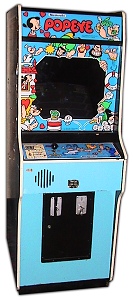 The Game: Well, blow me down! Popeye the sailor man gets his own video game. On level one, you’re trying to catch Olive Oyl’s falling hearts before they descend to sea level and are lost, while ducking Bluto’s punches at the same time. A can of spinach appears every so often, giving you the opportunity to read the big bully the riot act (comic strip-style, of course). On level two, the falling hearts are replaced by falling musical notes, and you’ll need Wimpy’s hefty help to keep Swee’Pea from drifting away on a balloon. (Nintendo, 1983)
The Game: Well, blow me down! Popeye the sailor man gets his own video game. On level one, you’re trying to catch Olive Oyl’s falling hearts before they descend to sea level and are lost, while ducking Bluto’s punches at the same time. A can of spinach appears every so often, giving you the opportunity to read the big bully the riot act (comic strip-style, of course). On level two, the falling hearts are replaced by falling musical notes, and you’ll need Wimpy’s hefty help to keep Swee’Pea from drifting away on a balloon. (Nintendo, 1983)
Memories: A true licensing coup for relative newcomers Nintendo, this project hooked them up with the cartoon marketing savvy of King Features Syndicate (and don’t think for a moment that Nintendo didn’t soak up as much knowledge as it could to put to use on its next hot property, Mario Bros.) But even though it’s a well-loved and remembered game, it wasn’t Popeye’s first arcade outing.
Pac ‘N’ Pal
 The Game: Once again, you are a round yellow creature consisting of a mouth and nothing else, maneuvering around a relatively simple maze. But this time, you have a Pal! A little round green Pal who is here just to help you. (Pal appears to be wearing a little bow, so there’s no indication of whether or not Ms. Pac-Man knows about
The Game: Once again, you are a round yellow creature consisting of a mouth and nothing else, maneuvering around a relatively simple maze. But this time, you have a Pal! A little round green Pal who is here just to help you. (Pal appears to be wearing a little bow, so there’s no indication of whether or not Ms. Pac-Man knows about  Pac-Man’s pal…) Those four pesky monsters are back. This time, the handful of treats in each maze is locked away behind doors vaguely reminiscent of Super Pac-Man. These doors can be unlocked by munching one of the cards lying around the maze. Fruit will score points for you, but if you eat one of the two Galaxians in each maze, Pac-Man is briefly imbued with a super shout which stuns the monsters for a little while. The only problem? Pac’s Pal will grab the fruit or the Galaxians and…very slowly…get around to bringing it to him. Sometimes this helps – Pal is impervious to the monsters, and there are no power pellets to help Pac-Man this time – but sometimes Pal dimwittedly marches your much-needed Galaxian right into the middle of the monsters, making it inaccessible. (Bally/Midway, 1983)
Pac-Man’s pal…) Those four pesky monsters are back. This time, the handful of treats in each maze is locked away behind doors vaguely reminiscent of Super Pac-Man. These doors can be unlocked by munching one of the cards lying around the maze. Fruit will score points for you, but if you eat one of the two Galaxians in each maze, Pac-Man is briefly imbued with a super shout which stuns the monsters for a little while. The only problem? Pac’s Pal will grab the fruit or the Galaxians and…very slowly…get around to bringing it to him. Sometimes this helps – Pal is impervious to the monsters, and there are no power pellets to help Pac-Man this time – but sometimes Pal dimwittedly marches your much-needed Galaxian right into the middle of the monsters, making it inaccessible. (Bally/Midway, 1983)
Memories: Possibly the most bizarre entry in the Pac-Man series, this game is a little bit confusing…and is, perhaps, the final indication that Bally/Midway and Namco had gone to the Pac-Man well one too many times. By this time, the only resemblance the latest Pac-game bore to the original were the elements of Pac-Man, the monsters, and the maze. And don’t even ask where Pal came from. I haven’t a clue.
Mr. Do!’s Castle
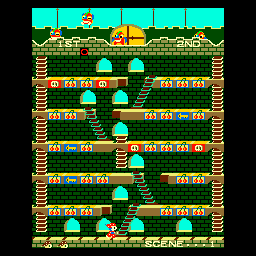 The Game: As cuddly clown Mr. Do, you’re scrambling to squish all the unicorns who are invading your castle. You can repel them momentarily with your clown hammer, but you can only squish them permanently by knocking a brick out from the floor above. Most bricks contain cherries, but some also contain keys that unlock the door at the top. When that door is completely unlocked, touching it will transform the unicorns into letters that make up the word EXTRA. As with Mr. Do!, collecting all five letters merits an extra “life.” Clearing the screen of monsters or cherries advances you to the next level. (Universal, 1983)
The Game: As cuddly clown Mr. Do, you’re scrambling to squish all the unicorns who are invading your castle. You can repel them momentarily with your clown hammer, but you can only squish them permanently by knocking a brick out from the floor above. Most bricks contain cherries, but some also contain keys that unlock the door at the top. When that door is completely unlocked, touching it will transform the unicorns into letters that make up the word EXTRA. As with Mr. Do!, collecting all five letters merits an extra “life.” Clearing the screen of monsters or cherries advances you to the next level. (Universal, 1983)
Memories: Another of my favorite obscure games, Mr. Do!’s Castle is truly cool, fun and addictive – all the requisite qualities of a good video game. In my mind, it easily outshines the original Mr. Do! by miles, and is one of the most unique and original entries in the ladders-and-levels genre since Donkey Kong.
Marble Madness
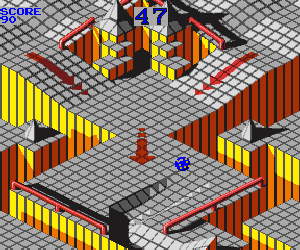
 The Game: You control the speed and direction of a marble which is racing other marbles to reach the finish line. Obstacles along the way include marble-eating creatures, treacherous cliffs and drawbridges, and the game’s own trakball controller! (Atari, 1983)
The Game: You control the speed and direction of a marble which is racing other marbles to reach the finish line. Obstacles along the way include marble-eating creatures, treacherous cliffs and drawbridges, and the game’s own trakball controller! (Atari, 1983)
Memories: One of the most bizarrely abstract games to emerge from the post-Pac-Man ’80s, Marble Madness is like a virtual homage to those wooden maze-under-glass games, in which you’d try to shift the game to various angles and get a ball bearing to go where you wanted it to go. Marble Madness does away with the moving-the-whole-maze element and puts the marble under its own power – and that’s just where the frustration begins!
Mappy
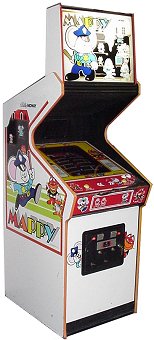
 The Game: Mappy the Mouse stars in “Micro Police!” You are Mappy, a mouse determined to bring Boss the Big Bit and his kooky kitty kohorts to justice before they make a huge hail on a house heist. You can snatch up the potential booty yourself to keep it safe, and can temporarily foil your feline foes by slamming doors on them, or by opening special glowing doors which blast them away with a burst of sound. If you snatch up all the treasures and avoid the cats, it’s off to the next level. Periodically, you get to pop balloons on a bonus level for extra points. (Bally/Midway [under license from Namco], 1983)
The Game: Mappy the Mouse stars in “Micro Police!” You are Mappy, a mouse determined to bring Boss the Big Bit and his kooky kitty kohorts to justice before they make a huge hail on a house heist. You can snatch up the potential booty yourself to keep it safe, and can temporarily foil your feline foes by slamming doors on them, or by opening special glowing doors which blast them away with a burst of sound. If you snatch up all the treasures and avoid the cats, it’s off to the next level. Periodically, you get to pop balloons on a bonus level for extra points. (Bally/Midway [under license from Namco], 1983)
Memories: You know, it’s just possible that Namco and Bally/Midway put the tail before the dog (or, in this case, the mouse) this time around. With the arcade cabinet’s positively mammoth marquee, and the hint that Mappy was the star of this game and would presumably star in future games, one wonders if the American distributors of Pac-Man were perhaps just a little too certain that everything coming out of their plants would be the dawn of a new franchise.
Mario Bros.
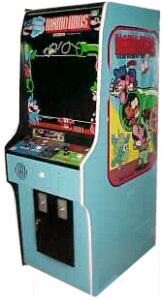 The Game: Twin brothers Mario and Luigi give up the illustrious life of ape-chasers and damsel-rescuers for their original line of work… plumbing. But this doesn’t mean the job’s any less dangerous. Killer lobsters and turtles abound in the sewer system (well, isn’t it that way everywhere?), along with airborne fireballs not unlike the foxfires in the original Donkey Kong. Another key event in this game? Nintendo solidifies its near-total dominance of the video game industry for the better part of the following decade and a half. (Nintendo, 1983)
The Game: Twin brothers Mario and Luigi give up the illustrious life of ape-chasers and damsel-rescuers for their original line of work… plumbing. But this doesn’t mean the job’s any less dangerous. Killer lobsters and turtles abound in the sewer system (well, isn’t it that way everywhere?), along with airborne fireballs not unlike the foxfires in the original Donkey Kong. Another key event in this game? Nintendo solidifies its near-total dominance of the video game industry for the better part of the following decade and a half. (Nintendo, 1983)
Memories: The fourth game in an ongoing line of coin-ops starring either Mario or some member of Donkey Kong’s family, Mario Bros. cemented the rotund plumber as the star of the show, rather than a simian’s sidekick.
Marvin’s Maze
 The Game: Marvin built a maze on two levels, with habitrail-style tunnels to take him from the first floor to the second and back again, and all was well until the Robonoids moved in and took over. Now they’re out to evict Marvin from his own turf! It’s up to you to guide Marvin through his maze, using cunning one-way bridges to escape from the Robonoids and find the power-ups he needs to zap them. Marvin moves on to the next maze (and the next level of difficulty) only by clearing this maze of power-ups and dots. (SNK, 1983)
The Game: Marvin built a maze on two levels, with habitrail-style tunnels to take him from the first floor to the second and back again, and all was well until the Robonoids moved in and took over. Now they’re out to evict Marvin from his own turf! It’s up to you to guide Marvin through his maze, using cunning one-way bridges to escape from the Robonoids and find the power-ups he needs to zap them. Marvin moves on to the next maze (and the next level of difficulty) only by clearing this maze of power-ups and dots. (SNK, 1983)
Memories: I hadn’t heard of this one before, and now I wonder why. In a way, there’s more than a passing resemblance to Crystal Castles, but there’s also a little bit of an homage to Pac-Man‘s power pellets and a little bit of shooting too. So now it’s like Crystal Butt-Kickin’ Castles. With cute character designs that are worthy of Q*Bert.
Krull
 The Game: In the video-game adaptation of the movie – which, at the time, was expected to be the next Star Wars-type franchise – you are Colwyn, the hero of the piece. Your first job is to climb a treacherous mountain, dodging boulders, and finding the five pieces of the throwing-star-like Glaive weapon. On the second level, you get to use it against a bunch of nasty swamp creatures who are trying to kill your army. You get to do this for two levels. Then you have to break your men out of a stronghold, and then lead the fight against the invincible chief monster, all to save the princess. (Gottlieb, 1983)
The Game: In the video-game adaptation of the movie – which, at the time, was expected to be the next Star Wars-type franchise – you are Colwyn, the hero of the piece. Your first job is to climb a treacherous mountain, dodging boulders, and finding the five pieces of the throwing-star-like Glaive weapon. On the second level, you get to use it against a bunch of nasty swamp creatures who are trying to kill your army. You get to do this for two levels. Then you have to break your men out of a stronghold, and then lead the fight against the invincible chief monster, all to save the princess. (Gottlieb, 1983)
Memories: Krull wasn’t a bad little game. It might take you a few quarters to get through, and that last level with the main monster was a killer. In a way, Krull is sort of like the opposite of Tron – whereas Tron is best remembered as a game and not a movie, Krull is virtually forgotten as a video game, and the movie still enjoys a small cult following.
Gravitar
 The Game: Various worlds lie near a powerful gravitational vortex. From the moment you leave your launch pad, you’re in trouble – the vortex will draw you in if you don’t act quickly and fire your thrusters to take you to one of the planets. On each planet, you arrive in a deadly free-fall, requiring you to point your ship
The Game: Various worlds lie near a powerful gravitational vortex. From the moment you leave your launch pad, you’re in trouble – the vortex will draw you in if you don’t act quickly and fire your thrusters to take you to one of the planets. On each planet, you arrive in a deadly free-fall, requiring you to point your ship  upward and fire retro-thrust, all the while turning to blast cannons which are attempting to shoot you down. Your fuel supply is also dwindling all this time, requiring you to find enemy fuel depots and siphon energy away from them. If you succeed in destroying all enemy installations on one world, there are several other planets waiting – with the deadly gravity vortex in the middle the whole time. (Atari, 1983)
upward and fire retro-thrust, all the while turning to blast cannons which are attempting to shoot you down. Your fuel supply is also dwindling all this time, requiring you to find enemy fuel depots and siphon energy away from them. If you succeed in destroying all enemy installations on one world, there are several other planets waiting – with the deadly gravity vortex in the middle the whole time. (Atari, 1983)
Memories: Damn, but this is a tough game! Tough but fun. It’s pretty embarrassing to get oneself iced on what basically amounts to the menu screen. Sheesh. Not that I’m saying that’s happened to me lately, of course.
Guzzler
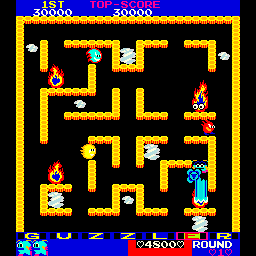 The Game: As a fluid little fellow, you zip around a maze flooded with flaming foes who’ll fry you with fire without fair warning. However, since water can put out fire, you can belch forth a mighty stream of water at your enemies, extinguishing them instantly. However, you’re only a little Guzzler, so you only contain a certain amount of water. You replenish yourself very slowly, but you can gobble up clouds full of moisture or drink from a fountain that occasionally appears at the center of the maze to refill yourself more quickly. And some fires are bigger than others, and putting them out will accordingly take more out of you. And you do eventually run out of clouds… (Tekhan, 1983)
The Game: As a fluid little fellow, you zip around a maze flooded with flaming foes who’ll fry you with fire without fair warning. However, since water can put out fire, you can belch forth a mighty stream of water at your enemies, extinguishing them instantly. However, you’re only a little Guzzler, so you only contain a certain amount of water. You replenish yourself very slowly, but you can gobble up clouds full of moisture or drink from a fountain that occasionally appears at the center of the maze to refill yourself more quickly. And some fires are bigger than others, and putting them out will accordingly take more out of you. And you do eventually run out of clouds… (Tekhan, 1983)
Memories: An incredibly fun, easy-to-learn, challenging, and cute game, Guzzler was always a favorite of mine, though I only got to play it in the arcade a handful of times. But this innovative take on the maze-chase theme that pervaded many an ’80s arcade game appears to have barely made a drop in the bucket of video game history.
Food Fight
 The Game: You are Charley – but you don’t have the Golden Ticket. Instead, what you have is a playfield littered with immobilizing potholes, lots of food, and four feisty chefs (is there a different word for the plural of “chef”?). Charley Chuck can pick up handfuls of food and fling them at any one of his opponents, but keep in mind that they can do the same. Charley’s ultimate goal? Reach the yummy ice cream cone at the opposite end of the screen without falling victim to any of the above. To do any less causes every piece of food on the screen to hurl itself at Charley. (Atari, 1983)
The Game: You are Charley – but you don’t have the Golden Ticket. Instead, what you have is a playfield littered with immobilizing potholes, lots of food, and four feisty chefs (is there a different word for the plural of “chef”?). Charley Chuck can pick up handfuls of food and fling them at any one of his opponents, but keep in mind that they can do the same. Charley’s ultimate goal? Reach the yummy ice cream cone at the opposite end of the screen without falling victim to any of the above. To do any less causes every piece of food on the screen to hurl itself at Charley. (Atari, 1983)
Memories: This bizarre little game is the first original arcade effort from a small game design firm called General Computer, which was actually responsible for Ms. Pac-Man, which started out as an unauthorized modification kit. Caught in the act, General Computer’s founders offered the game to Namco, and it went on to become the best-earning arcade game of its day. A similar “enhancement” devised for Atari’s Missile Command, however, got them in hot water.
The Empire Strikes Back

 The Game: You are Rebel snowspeeder pilot Luke Skywalker, flying low over the surface of Hoth, prowling for Probots and waging war on AT-ATs and AT-STs. (Atari, 1983)
The Game: You are Rebel snowspeeder pilot Luke Skywalker, flying low over the surface of Hoth, prowling for Probots and waging war on AT-ATs and AT-STs. (Atari, 1983)
Memories: The description sounds rather glib, but there’s a simple reason for it – this game, based on the 1980 sequel to Star Wars, is – in case you hadn’t guessed it from the screen shots – merely a very thinly-disguised makeover of Atari’s original Star Wars arcade game. Ripped straight out of the second level of Star Wars, The Empire Strikes Back replaces the towers and bunkers with probe droids and Imperial Walkers, replaces the X-Wing gunsights of the earlier game with two Snowspeeder blasters, and voilà , it’s a new game – almost.
Elevator Action
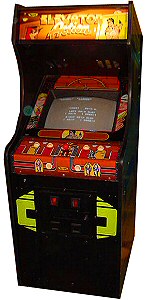 The Game: Love in an elevator, it’s not. As a daring spy, you break into a top secret enemy facility, trying to grab vital secrets and evade or kill as many enemy agents as you can. Your only means of getting from floor to floor through most of the game is via the elevator – which gives you an advantage and also makes you vulnerable. (Taito, 1983)
The Game: Love in an elevator, it’s not. As a daring spy, you break into a top secret enemy facility, trying to grab vital secrets and evade or kill as many enemy agents as you can. Your only means of getting from floor to floor through most of the game is via the elevator – which gives you an advantage and also makes you vulnerable. (Taito, 1983)
 Memories: This neat little entry from Taito wound up eating a lot of my allowance money back when I was eleven years old. There was a genuine sense of trying to reach a goal (though, to this day, even with emulation and official retro collections, I have no idea what lies below, say, the 20th level of the enemy compound). Elevator Action is also a real test of one’s mental multitasking abilities: agents closing in on all sides, elevator going down…do you jump? Duck? Shoot the agents? Shoot out the overhead lights? Some combination of the above? Whew.
Memories: This neat little entry from Taito wound up eating a lot of my allowance money back when I was eleven years old. There was a genuine sense of trying to reach a goal (though, to this day, even with emulation and official retro collections, I have no idea what lies below, say, the 20th level of the enemy compound). Elevator Action is also a real test of one’s mental multitasking abilities: agents closing in on all sides, elevator going down…do you jump? Duck? Shoot the agents? Shoot out the overhead lights? Some combination of the above? Whew.
Bubbles

 The Game: This is an interactive documentary about the life of a Scrubbing Bubble. As a small bubble, your job is to scoot around the sink, soaking up smaller bubbles, bits of dirt, and any ants that wander into your path. As you accrete more common kitchen debris, your bubble grows bigger and begins to form a face. When your bubble is big enough to sport a big ant-eating grin, you can start to do real damage. Razor blades are always deadly; roving brushes are deadly until your bubble has a mouth, and roaches are deadly unless you can dispatch them with a broom that periodically appears. When the drain at the center of the sink flashes green, you can slide down the drain and advance a level – something which you can only otherwise accomplish by clearing the sink of “edible” items. (Williams Electronics, 1983)
The Game: This is an interactive documentary about the life of a Scrubbing Bubble. As a small bubble, your job is to scoot around the sink, soaking up smaller bubbles, bits of dirt, and any ants that wander into your path. As you accrete more common kitchen debris, your bubble grows bigger and begins to form a face. When your bubble is big enough to sport a big ant-eating grin, you can start to do real damage. Razor blades are always deadly; roving brushes are deadly until your bubble has a mouth, and roaches are deadly unless you can dispatch them with a broom that periodically appears. When the drain at the center of the sink flashes green, you can slide down the drain and advance a level – something which you can only otherwise accomplish by clearing the sink of “edible” items. (Williams Electronics, 1983)
Memories: Okay, and the designers at Williams were smoking what, exactly, when they dreamed this one up?
But I kid Bubbles. It’s actually a pretty cool game, and a rare example of a cutesy game from Williams, a company which usually turned out such macho, kill-’em-all shooters as Defender, Sinistar and Robotron. Williams’ only other entry in the cute game genre was Make Trax (which almost doesn’t count, since it was licensed from an obscure Japanese manufacturer).
Botanic
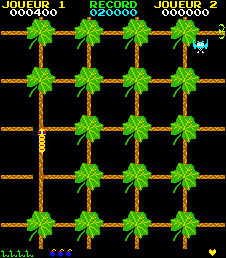 The Game: Players control a caterpillar, hungrily navigating a twisty maze of twigs and branches to eat leaves. Sometimes the player’s caterpillar will have reached a dead end, but this is not revealed until the leaf covering that dead end is consumed. Other insects swarm around the caterpillar, trying to catch and eat it for themselves. At the beginning of each “life” the player can press a button, giving the caterpillar a brief bug-zerker rage, allowing it to eat its enemies for a change, but this change is short-lived; special flowers must be consumed to regain the ability. Once all of the leaves have been eaten in an entire maze (which takes up more than a single interlinked screen), a “home” appears, into which the caterpillar must be successfully guided for transformation into a butterfly. Then the player is given a new caterpillar to guide and a new maze to navigate. (Valadon Automation [under license to Iti S.A.], 1983)
The Game: Players control a caterpillar, hungrily navigating a twisty maze of twigs and branches to eat leaves. Sometimes the player’s caterpillar will have reached a dead end, but this is not revealed until the leaf covering that dead end is consumed. Other insects swarm around the caterpillar, trying to catch and eat it for themselves. At the beginning of each “life” the player can press a button, giving the caterpillar a brief bug-zerker rage, allowing it to eat its enemies for a change, but this change is short-lived; special flowers must be consumed to regain the ability. Once all of the leaves have been eaten in an entire maze (which takes up more than a single interlinked screen), a “home” appears, into which the caterpillar must be successfully guided for transformation into a butterfly. Then the player is given a new caterpillar to guide and a new maze to navigate. (Valadon Automation [under license to Iti S.A.], 1983)
Memories: If you remember playing Botanic in your local arcade, your local arcade must have been in France or Spain, since Botanic did not receive worldwide distribution. Valadon Automation, the originators of Bagman (a game which did receive worldwide distribution), licensed Botanic from Palamos, Spain-based game maker Iti S.A.
Satan’s Hollow
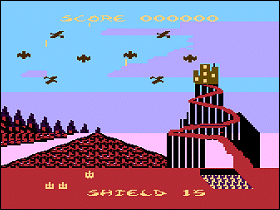 The Game: Hellish flying demons try to formation-dive your well-armed, devil-fryin’ vehicle at the bottom of the screen. Each time you knock one of this gargoylesque beasties out of the sky, they drop a piece of a bridge you must drag over to the appropriate spot on the screen. When you’re close to completing the bridge, the Prince of Darkness sends in some heavier artillery – a spooky floating demon head who spits fire at your cannon – to do away with you. Once you’ve toasted the flying meanies out of the sky and cross the bridge, it’s time to do battle with Satan himself. (CBS Video Games, 1982)
The Game: Hellish flying demons try to formation-dive your well-armed, devil-fryin’ vehicle at the bottom of the screen. Each time you knock one of this gargoylesque beasties out of the sky, they drop a piece of a bridge you must drag over to the appropriate spot on the screen. When you’re close to completing the bridge, the Prince of Darkness sends in some heavier artillery – a spooky floating demon head who spits fire at your cannon – to do away with you. Once you’ve toasted the flying meanies out of the sky and cross the bridge, it’s time to do battle with Satan himself. (CBS Video Games, 1982)
Memories: CBS’ home video game division was focused on releasing a library consisting largely of arcade games licensed from Bally/Midway on cartridge for the Atari 2600. But CBS wasn’t content to limit itself to a single platform (unlike quite a few third-party software houses that appeared in the wake of the stellar success of Activision and Imagic). They also had the Atari computers in their sight, which also put them in a good position to release games for the Atari 5200, which was based on the same processor.
Rocky’s Boots
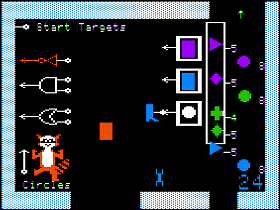 The Game: Rocky is trying to build machines to kick stuff. He provides players with a number of connectors and components, and shows them how they can be used to achieve different tasks. (The Learning Company, 1982)
The Game: Rocky is trying to build machines to kick stuff. He provides players with a number of connectors and components, and shows them how they can be used to achieve different tasks. (The Learning Company, 1982)
Memories: Fresh from leaving Atari and then taking a vacation, game designer and programmer Warren Robinett was ready to get back into the game, literally. But he had languished in anonymity at Atari as one of the last holdouts at a time when many of the company’s original pool of programming talent was defecting to Activision and Imagic; when Robinett returned to game making, he’d do it on his own terms.
Parsec
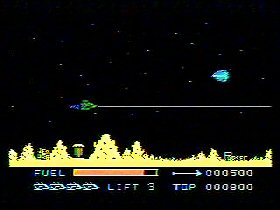 The Game: You control a space patrol fighter cruising over the surface of a planet. Alien attackers swarm on the right side of the screen and strafe you, and you must get out of the way of their laser fire and return some of your own; the more enemy ships you allow to safely leave the screen, the more you’ll have to deal with when they re-enter from the right side of the screen. Avoid their fire, avoid colliding with them, and avoid slamming into the ground, and you might just live long enough to repel the invasion. (Texas Instruments, 1982)
The Game: You control a space patrol fighter cruising over the surface of a planet. Alien attackers swarm on the right side of the screen and strafe you, and you must get out of the way of their laser fire and return some of your own; the more enemy ships you allow to safely leave the screen, the more you’ll have to deal with when they re-enter from the right side of the screen. Avoid their fire, avoid colliding with them, and avoid slamming into the ground, and you might just live long enough to repel the invasion. (Texas Instruments, 1982)
Memories: This fun little side-scrolling shooter, very much along the lines of Defender, Scramble or Cosmic Avenger, is a showcase for the TI99/4A’s graphics capability. The spaceships are fine line art in motion, and the ground especially is crisp and rich with detail, including Texas Instruments and Parsec logos carved out of the landscape.
Turbo
 The Game: It’s pretty straightforward…you’re zipping along in your Formula One race car, trying to avoid other drivers and obstacles along the way while hauling a sufficient quantity of butt to win the race. (Coleco [under license from Sega], 1982)
The Game: It’s pretty straightforward…you’re zipping along in your Formula One race car, trying to avoid other drivers and obstacles along the way while hauling a sufficient quantity of butt to win the race. (Coleco [under license from Sega], 1982)
Memories: One of the seminal first-person racing games of the 80s, Turbo was one of several Sega coin-ops that caught the eye of Coleco. The one hurdle in bringing it to the ColecoVision? Having to invent a whole new controller that would be similar enough to Turbo‘s arcade control scheme without being so specific as to rule out using the driving controller for other games in the future. And thus was born Expansion Module #2, a steering wheel controller with a detachable “gas pedal.”
Venture
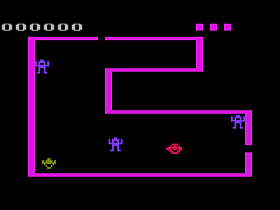 The Game: Trapped in a maze full of HallMonsters, you are adventurer Winky, on a mission to snatch incredible treasures from hazardous underground rooms inhabited by lesser beasts such as re-animated skeletons, goblins, serpents, and so on. Sometimes even the walls move, threatening to squish Winky or trap him, helpless to run from the HallMonsters. The deeper into the dungeons you go, the more treacherous the danger – and the greater the rewards. Just remember two things – the decomposing corpses of the smaller enemies are just as deadly as the live creatures. And there is no defense – and almost never any means of escape – from the HallMonsters. (Coleco, 1982)
The Game: Trapped in a maze full of HallMonsters, you are adventurer Winky, on a mission to snatch incredible treasures from hazardous underground rooms inhabited by lesser beasts such as re-animated skeletons, goblins, serpents, and so on. Sometimes even the walls move, threatening to squish Winky or trap him, helpless to run from the HallMonsters. The deeper into the dungeons you go, the more treacherous the danger – and the greater the rewards. Just remember two things – the decomposing corpses of the smaller enemies are just as deadly as the live creatures. And there is no defense – and almost never any means of escape – from the HallMonsters. (Coleco, 1982)
Memories: Coleco was widely rumored to be deliberately making its third-party games for Atari and Intellivision total stinkers – look up the 2600 version of Donkey Kong or the even more miserable Intellivision version sometime. But Venture for the VCS was a bit of a surprise: it wasn’t a total stink bomb of a game.
Venture
 The Game: As intrepid (and perpetually happy) adventurer Winky, armed only with a bow and arrow, you’re on a treasure hunt of the deadliest kind. HallMonsters try to stop you at every turn, and their minions guard the individual treasures that lie in the rooms of the maze. You can kill the smaller creatures (though their decomposing remains are still deadly to touch), but the HallMonsters are impervious to your arrows – and you’re lunch. (Coleco, 1982)
The Game: As intrepid (and perpetually happy) adventurer Winky, armed only with a bow and arrow, you’re on a treasure hunt of the deadliest kind. HallMonsters try to stop you at every turn, and their minions guard the individual treasures that lie in the rooms of the maze. You can kill the smaller creatures (though their decomposing remains are still deadly to touch), but the HallMonsters are impervious to your arrows – and you’re lunch. (Coleco, 1982)
Memories: Based on the addictive arcade game, this game is an excellent home translation, complete with background music and sound effects. Though the ColecoVision was more than capable of displaying more colorful and more detailed graphics, Venture is one of the better “simple” games made for this console.
Vanguard
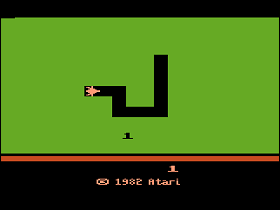 The Game: Your Vanguard space fighter has infiltrated a heavily-defended alien base. The enemy outnumbers you by six or seven to one at any given time (thank goodness for animated sprite limitations, or you’d be in real trouble!). You can fire above, below, ahead and behind your ship, which is an art you’ll need to master since enemy ships attack from all of these directions. You can’t run into any of the walls and expect to survive, but you can gain brief invincibility by flying through an Energy block, which supercharges your hull enough to ram your enemies (something which, at any other time, would mean certain death for you as well). At the end of your treacherous journey lies the alien in charge of the entire complex – but if you lose a life at that stage, you don’t get to come back for another shot! (Atari, 1982)
The Game: Your Vanguard space fighter has infiltrated a heavily-defended alien base. The enemy outnumbers you by six or seven to one at any given time (thank goodness for animated sprite limitations, or you’d be in real trouble!). You can fire above, below, ahead and behind your ship, which is an art you’ll need to master since enemy ships attack from all of these directions. You can’t run into any of the walls and expect to survive, but you can gain brief invincibility by flying through an Energy block, which supercharges your hull enough to ram your enemies (something which, at any other time, would mean certain death for you as well). At the end of your treacherous journey lies the alien in charge of the entire complex – but if you lose a life at that stage, you don’t get to come back for another shot! (Atari, 1982)
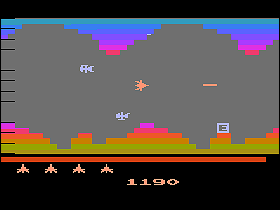
 Memories: Viva Vanguard! I remember quite a few of my buddies at the time preferring this cartridge edition to the arcade game that inspired it, and with a little bit of thought it’s easy to see why. With only one button, Atari’s home version of Vanguard allowed players to dispense with the arcade’s compass rose of fire buttons; for lack of any better way to handle it, this version of Vanguard just unleashed white-hot electric death in all directions everytime the fire button was pressed. Hey, problem solved! No more getting broadsided by enemies dropping down from above. Simple, elegant. Even those of us who regularly got our butts handed to us by the coin-op could be Vanguard victors now.
Memories: Viva Vanguard! I remember quite a few of my buddies at the time preferring this cartridge edition to the arcade game that inspired it, and with a little bit of thought it’s easy to see why. With only one button, Atari’s home version of Vanguard allowed players to dispense with the arcade’s compass rose of fire buttons; for lack of any better way to handle it, this version of Vanguard just unleashed white-hot electric death in all directions everytime the fire button was pressed. Hey, problem solved! No more getting broadsided by enemies dropping down from above. Simple, elegant. Even those of us who regularly got our butts handed to us by the coin-op could be Vanguard victors now.
Turmoil
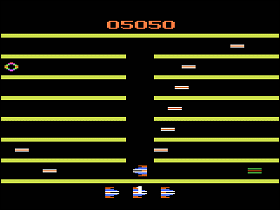 The Game: Players pilot a ship trapped in a maze of vertically stacked level, teeming with aliens who are all deadly to the touch. The good news is that the ship has an inexhaustible supply of ammo. The not-so-good news is that the bad guys have an inexhaustible supply of bad guys. Players have to keep the ship from colliding with the enemy, while shooting at the enemy and watching out for split-second opportunities to grab any bonus items that may make a fleeting appearance. Just one word of caution: the prizes turn into smart bombs if you wait too long to go pick them up. (20th Century Fox, 1982)
The Game: Players pilot a ship trapped in a maze of vertically stacked level, teeming with aliens who are all deadly to the touch. The good news is that the ship has an inexhaustible supply of ammo. The not-so-good news is that the bad guys have an inexhaustible supply of bad guys. Players have to keep the ship from colliding with the enemy, while shooting at the enemy and watching out for split-second opportunities to grab any bonus items that may make a fleeting appearance. Just one word of caution: the prizes turn into smart bombs if you wait too long to go pick them up. (20th Century Fox, 1982)
Memories: Similar in execution to other “vertical shooters” like Ram It!, Turmoil has speed on its side, along with the cruel twist of forcing the player to retrieve bonuses that may blow up in his face.
Tron Deadly Discs
 The Game: You are Tron, a lone video game warrior pitted against three other enemies with much greater armament. You can take a number of hits before you’re “de-rezzed” out of existence, but those hits can pile up pretty quickly. By throwing your disc at certain portions of the arena wall and changing them to the same color as your on-screen character, you can make tunnels for yourself – not unlike the side tunnels in Pac-Man – handy for escape or ambush. Every so often, however, a Recognizer will enter the arena, send out a force field to attempt to hold Tron immobile, and will close off those exits to restore the odds in favor of the house. If the Recognizer crushes Tron, that’ll end the game as quickly as letting the video warriors blast him repeatedly. (Mattel, 1982)
The Game: You are Tron, a lone video game warrior pitted against three other enemies with much greater armament. You can take a number of hits before you’re “de-rezzed” out of existence, but those hits can pile up pretty quickly. By throwing your disc at certain portions of the arena wall and changing them to the same color as your on-screen character, you can make tunnels for yourself – not unlike the side tunnels in Pac-Man – handy for escape or ambush. Every so often, however, a Recognizer will enter the arena, send out a force field to attempt to hold Tron immobile, and will close off those exits to restore the odds in favor of the house. If the Recognizer crushes Tron, that’ll end the game as quickly as letting the video warriors blast him repeatedly. (Mattel, 1982)
 Memories: Easily the most playable of the three Intellivision games based on Tron, Deadly Discs was also later ported to the Atari 2600, and despite the nice graphical bells and whistles bestowed upon this edition, it’s the 2600 version of the game which is most playable.
Memories: Easily the most playable of the three Intellivision games based on Tron, Deadly Discs was also later ported to the Atari 2600, and despite the nice graphical bells and whistles bestowed upon this edition, it’s the 2600 version of the game which is most playable.